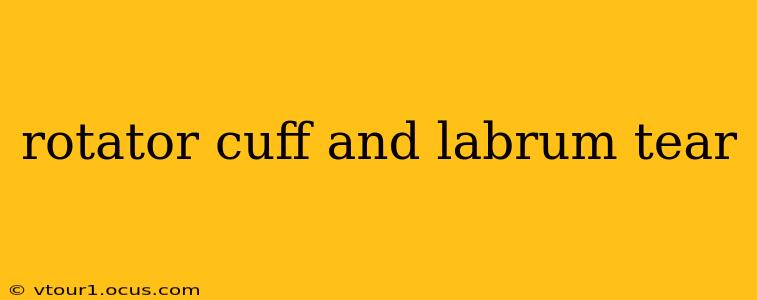The shoulder is a complex joint, a marvel of engineering allowing for a wide range of motion. However, this versatility comes at a cost – it's prone to injury. Two common and often interconnected injuries are rotator cuff tears and labrum tears. Understanding these injuries, their symptoms, diagnosis, and treatment is crucial for effective recovery.
What is a Rotator Cuff Tear?
The rotator cuff is a group of four muscles and their tendons that surround the shoulder joint, providing stability and enabling movement. A rotator cuff tear occurs when one or more of these tendons are torn. This can range from a small, partial tear to a complete rupture. Tears can be caused by sudden trauma, such as a fall or impact, or by repetitive overuse, common in athletes or individuals with physically demanding jobs.
Symptoms of a Rotator Cuff Tear: These can vary depending on the severity of the tear but often include:
- Shoulder pain: This can range from mild to severe, often worsening with movement or activity.
- Weakness: Difficulty lifting or rotating the arm.
- Limited range of motion: Inability to fully raise or rotate the arm.
- Clicking or popping: Sounds emanating from the shoulder joint during movement.
- Swelling: Inflammation around the shoulder joint.
What is a Labrum Tear?
The labrum is a ring of cartilage that lines the shoulder socket, deepening it and providing stability to the joint. A labrum tear is a damage to this cartilage, often caused by a sudden injury, such as a fall or forceful twisting motion. Repetitive overhead movements can also contribute to a labrum tear over time. This injury is common in athletes who participate in sports involving throwing or overhead movements.
Symptoms of a Labrum Tear: Similar to a rotator cuff tear, symptoms can vary but often include:
- Shoulder pain: This pain may be deep within the shoulder or radiate down the arm.
- Clicking or popping: A distinct sound or sensation felt within the shoulder joint.
- Instability: A feeling of the shoulder "giving way" or "slipping out."
- Limited range of motion: Difficulty with certain movements.
- Weakness: Reduced strength in the shoulder.
Can you have a rotator cuff tear and a labrum tear at the same time?
Yes. It's quite common to have both a rotator cuff tear and a labrum tear simultaneously. These injuries often occur together because the same mechanisms (trauma or overuse) can affect both structures. The labrum and rotator cuff work together to provide shoulder stability, so damage to one often compromises the other. Proper diagnosis is essential to ensure effective treatment.
How are rotator cuff and labrum tears diagnosed?
Diagnosis typically involves a combination of:
- Physical examination: The doctor will assess your range of motion, strength, and the location of your pain.
- Imaging tests: X-rays may rule out fractures, while an MRI provides detailed images of the soft tissues (muscles, tendons, ligaments, and cartilage) to identify tears. An arthrogram (MRI arthrogram) may be used to better visualize the labrum.
How are rotator cuff and labrum tears treated?
Treatment depends on the severity of the injury and the individual's symptoms. Options include:
- Non-surgical treatment: This often involves rest, ice, physical therapy, and pain medication. Physical therapy plays a vital role in strengthening the shoulder muscles and improving range of motion.
- Surgical treatment: Surgery may be necessary for significant tears that don't respond to conservative treatment. Arthroscopic surgery is a minimally invasive technique often used to repair rotator cuff and labrum tears.
What is the recovery time for a rotator cuff and labrum tear?
Recovery time varies greatly depending on the severity of the injury, the type of treatment received, and individual factors such as age and overall health. Non-surgical recovery can take several weeks to months, while surgical recovery can take several months to a year or more. Consistent physical therapy is crucial throughout the recovery process.
How can I prevent rotator cuff and labrum tears?
Prevention strategies include:
- Warm-up properly before exercise: Preparing your muscles for activity reduces the risk of injury.
- Maintain good posture: Proper posture helps to distribute weight and stress evenly across the shoulder joint.
- Strengthen your shoulder muscles: Regular exercise to strengthen the muscles surrounding the shoulder joint increases its stability.
- Use proper lifting techniques: Avoid lifting heavy objects improperly.
- Avoid repetitive overhead movements: If you have a job or hobby that involves repetitive overhead movements, consider taking breaks and modifying your technique to reduce stress on your shoulder.
This information is intended for general knowledge and informational purposes only, and does not constitute medical advice. Always consult with a healthcare professional for any health concerns or before making any decisions related to your health or treatment.
